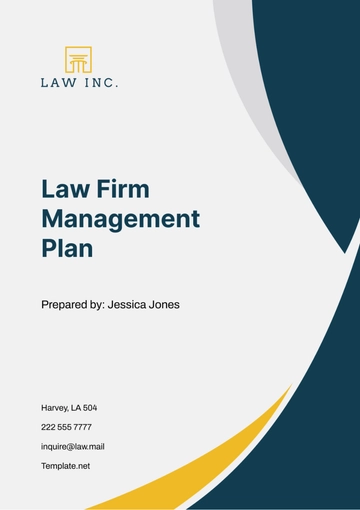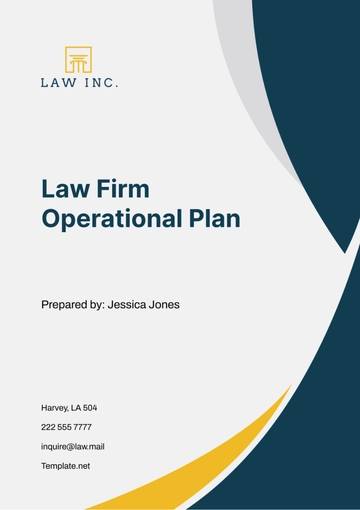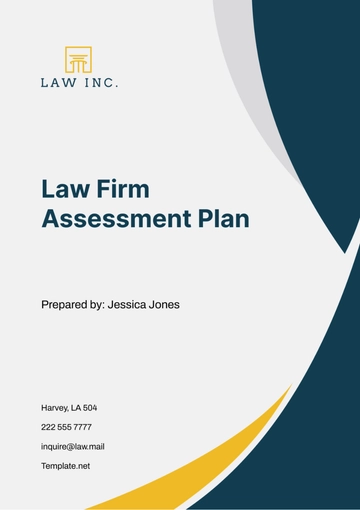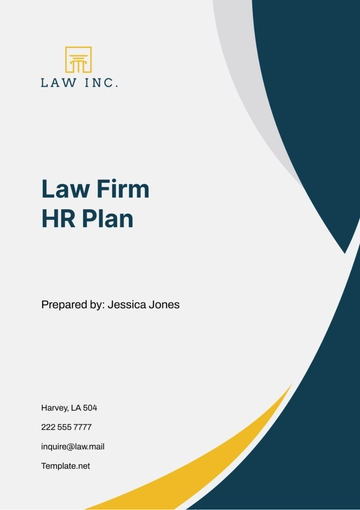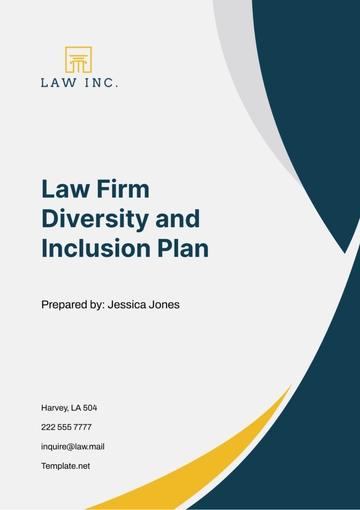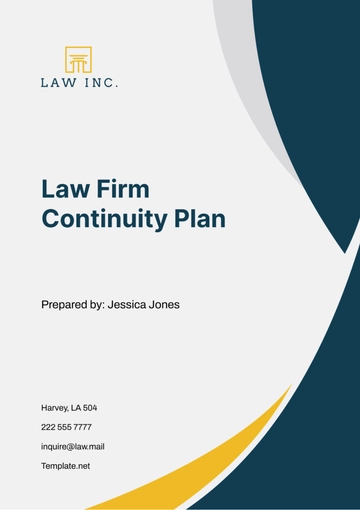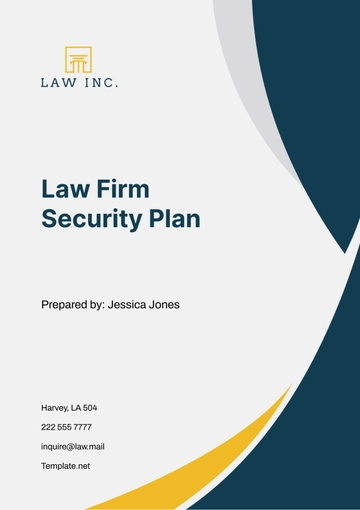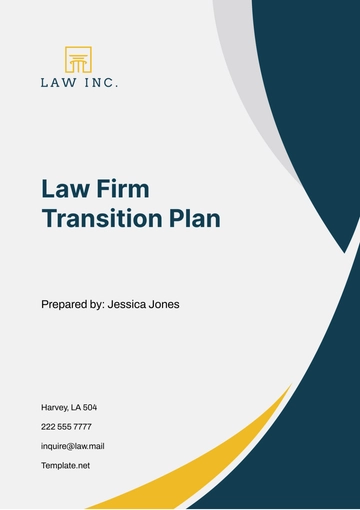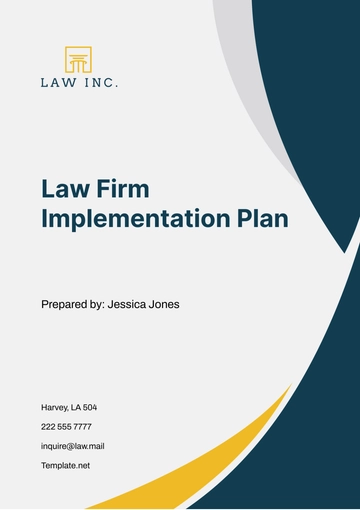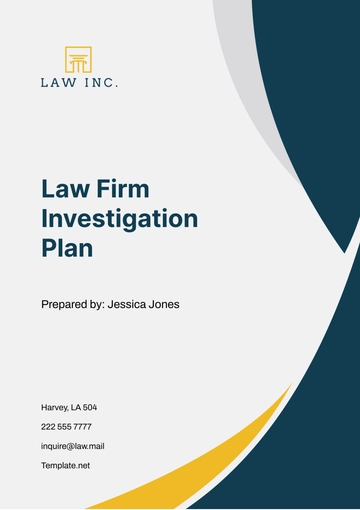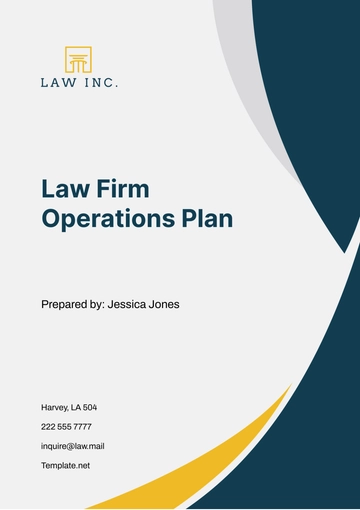Free Law Firm Security Plan

I. Introduction
At [Your Company Name], we recognize the paramount importance of safeguarding sensitive information, ensuring client confidentiality, and maintaining the highest standards of security within our operations. This Security Plan outlines our commitment to implementing comprehensive security measures to protect against potential risks and threats to our firm and our clients.
II. Objectives
Protect Client Confidentiality: Ensure the confidentiality, integrity, and availability of client information and legal documents entrusted to our firm.
Mitigate Security Risks: Identify and mitigate potential security risks and vulnerabilities to prevent unauthorized access, disclosure, or loss of sensitive data.
Ensure Compliance: Ensure compliance with relevant laws, regulations, and industry standards governing data protection and security, including GDPR, HIPAA, and ABA Model Rules of Professional Conduct.
Maintain Trust: Maintain the trust and confidence of our clients by demonstrating our commitment to security and confidentiality in all aspects of our operations.
III. Risk Assessment
A thorough risk assessment will be conducted annually to identify potential security risks and vulnerabilities within our firm's operations, infrastructure, and systems. This assessment will include:
Risk Category | Potential Risks and Vulnerabilities | Likelihood | Impact | Priority |
|---|---|---|---|---|
Physical Security | Unauthorized access to premises | Medium | High | High |
Theft or loss of physical assets | Low | Medium | Medium | |
Information Security | Unauthorized access to client data | High | High | High |
Data breaches or leaks | Medium | High | High | |
Cybersecurity | Malware infections | High | High | High |
Phishing attacks | High | High | High | |
Insider threats | Medium | High | High | |
Compliance | Non-compliance with data protection laws | Medium | High | High |
IV. Access Control
Access control measures are essential to limit access to physical premises, sensitive information, and electronic systems to authorized personnel only. At [Your Company Name], we prioritize access control to safeguard client confidentiality and protect our firm's assets. Our approach includes:
Authentication Mechanisms:
Password-based authentication with regular password updates and complexity requirements.
Implementation of multi-factor authentication (MFA) for an additional layer of security.
Biometric authentication where applicable, such as fingerprint or facial recognition.
Access Controls:
Implementing role-based access control (RBAC) to assign permissions based on job roles and responsibilities. This ensures that employees have access only to the information and systems necessary for their duties.
Adhering to the principle of least privilege, granting users the minimum level of access required to perform their tasks effectively.
Regularly reviewing and updating access permissions to reflect changes in employee roles or responsibilities.
Physical Security Measures:
Employing physical security measures, such as locks, key cards, and surveillance cameras, to control access to our premises.
Implementing visitor management procedures to ensure that guests are properly authorized and escorted while on-site.
Remote Access:
Enabling secure remote access for authorized personnel through virtual private networks (VPNs) or other encrypted connections.
Implementing strong authentication and access controls for remote access to protect against unauthorized entry into our systems.
Monitoring and Logging:
Monitoring access to sensitive information and systems through audit logs and access control reports.
Regularly reviewing access logs to identify and investigate any suspicious or unauthorized access attempts.
V. Data Protection
Data protection is paramount to [Your Company Name]'s commitment to safeguarding client confidentiality and ensuring the integrity of sensitive information. Our data protection measures include:
Encryption: Implementing encryption protocols to secure data both at rest and in transit, minimizing the risk of unauthorized access or interception.
Access Controls: Establishing access controls and permissions to restrict unauthorized access to client information, ensuring that only authorized personnel can view, modify, or delete sensitive data.
Secure Storage: Storing sensitive data in secure, centralized repositories with access controls and regular backups to prevent data loss and facilitate disaster recovery efforts.
Data Retention Policies: Implementing data retention policies to define the duration for which client data is retained and establishing procedures for securely disposing of data that is no longer needed.
Confidentiality Agreements: Requiring employees, contractors, and third-party vendors to sign confidentiality agreements outlining their obligations to protect client information and maintain confidentiality.
Secure Disposal: Implementing procedures for securely disposing of physical and electronic media containing sensitive information, such as shredding paper documents and wiping electronic storage devices.
Data Breach Response: Developing and regularly updating incident response plans to address data breaches promptly, including notifying affected parties, investigating the root cause, and implementing corrective measures to prevent future incidents.
VI. Cybersecurity
Cybersecurity is a critical component of [Your Company Name]'s security strategy, aimed at protecting our firm's digital assets, client information, and systems from cyber threats. Our cybersecurity measures include:
Firewalls: Deploying firewalls at network perimeters to monitor and filter incoming and outgoing network traffic, preventing unauthorized access and blocking malicious activities.
Intrusion Detection and Prevention Systems (IDPS): Implementing IDPS to detect and respond to suspicious activities or potential security breaches in real-time, minimizing the impact of cyber threats.
Antivirus and Antimalware Software: Installing and regularly updating antivirus and antimalware software on all endpoints to detect and remove malicious software, such as viruses, trojans, and ransomware.
Patch Management: Maintaining up-to-date software and operating systems by promptly applying security patches and updates to address known vulnerabilities and reduce the risk of exploitation by cyber attackers.
Secure Configuration: Configuring systems and applications securely, following industry best practices and security guidelines, to minimize the attack surface and mitigate the risk of unauthorized access or compromise.
VII. Employee Training and Awareness
Employees are often the first line of defense against security threats. To ensure that our staff is well-equipped to handle security incidents and protect client confidentiality, [Your Company Name] will provide training for:
Phishing Awareness: Providing comprehensive training to employees on how to recognize phishing attempts, including suspicious emails, messages, or phone calls, and how to avoid falling victim to phishing scams.
Password Security: Educating employees on the importance of creating strong, unique passwords and regularly updating them, as well as the risks associated with password sharing or writing down passwords.
Data Handling Best Practices: Training employees on proper data handling procedures, including securely storing and transmitting sensitive information, avoiding unauthorized access or disclosure, and following data protection policies.
Social Engineering Awareness: Raising awareness among employees about social engineering tactics used by cyber attackers to manipulate individuals into divulging confidential information or performing unauthorized actions.
Device Security: Providing guidance on securing company-issued and personal devices used for work, including implementing screen locks, enabling encryption, and installing antivirus software to protect against malware and other threats.
Incident Reporting: Establishing clear procedures for employees to report security incidents, suspicious activities, or potential vulnerabilities promptly, ensuring that incidents are addressed in a timely manner to minimize the impact on the firm and its clients.
VIII. Incident Response and Business Continuity
A. Incident Response
At [Your Company Name], we recognize the importance of prompt and effective incident response to mitigate the impact of security incidents and ensure the continuity of our business operations. Our Incident Response and Business Continuity Plan outlines the following procedures:
Incident Identification and Reporting: Employees are trained to promptly identify and report security incidents, including data breaches, malware infections, and suspicious activities, to the designated incident response team.
Response Team Activation: Upon receiving a report of a security incident, the incident response team is immediately activated to assess the situation, determine the scope and severity of the incident, and initiate the appropriate response measures.
Containment and Mitigation: The incident response team works to contain the incident and prevent further damage or unauthorized access. This may involve isolating affected systems, disabling compromised accounts, or implementing temporary security controls.
Investigation and Analysis: A thorough investigation is conducted to determine the root cause of the incident, identify any vulnerabilities or weaknesses in our systems or procedures, and gather evidence for potential legal or regulatory purposes.
Communication and Notification: Clear communication channels are established to keep stakeholders informed about the incident, including employees, clients, regulatory authorities, and law enforcement agencies, as required by applicable laws and regulations.
Remediation and Recovery: Once the incident has been contained and investigated, the incident response team works to remediate the impact of the incident and restore affected systems and services to normal operations. This may involve restoring data from backups, applying security patches, or implementing additional security controls.
Lessons Learned and Improvement: After the incident has been resolved, a post-incident review is conducted to analyze the effectiveness of our response efforts, identify areas for improvement, and update our incident response procedures accordingly to enhance our resilience to future incidents.
B. Business Continuity
In addition to incident response, [Your Company Name] maintains a comprehensive business continuity plan to ensure the continued operation of critical business functions in the event of disruptions, such as natural disasters, power outages, or other unforeseen events. Our business continuity plan includes:
Risk Assessment and Business Impact Analysis: Identifying potential risks and vulnerabilities to our business operations and conducting a business impact analysis to prioritize critical functions and resources for recovery.
Continuity Planning and Preparedness: Developing and documenting business continuity plans for critical business functions, outlining procedures for maintaining essential operations, relocating personnel, and accessing backup systems and data.
Backup and Redundancy: Implementing robust backup and redundancy measures to ensure the availability and integrity of data and systems, including offsite backups, redundant infrastructure, and cloud-based services.
Testing and Training: Regularly testing our business continuity plans through drills and exercises to evaluate their effectiveness and identify areas for improvement. Providing training and awareness programs to educate employees about their roles and responsibilities during business continuity events.
Coordination and Collaboration: Establishing clear lines of communication and coordination with key stakeholders, including employees, clients, vendors, and emergency responders, to facilitate a coordinated response to business continuity events.
IX. Compliance
[Your Company Name] is committed to maintaining compliance with relevant laws, regulations, and industry standards governing data protection and security. Our compliance efforts include adherence to the following laws and regulations:
General Data Protection Regulation (GDPR): [Your Company Name] ensures compliance with GDPR requirements regarding the processing and protection of personal data of individuals within the European Union (EU) and the European Economic Area (EEA).
Health Insurance Portability and Accountability Act (HIPAA): As applicable to our firm's operations, [Your Company Name] complies with HIPAA regulations governing the security and privacy of protected health information (PHI) in the healthcare industry.
ABA Model Rules of Professional Conduct: [Your Company Name] adheres to the American Bar Association (ABA) Model Rules of Professional Conduct, which govern the ethical obligations of attorneys regarding client confidentiality, competence, and communication.
State Data Breach Notification Laws: [Your Company Name] complies with state-specific data breach notification laws, which require organizations to notify individuals and regulatory authorities in the event of a data breach involving sensitive personal information.
Financial Industry Regulatory Authority (FINRA) Rules: If applicable to our firm's activities, [Your Company Name] adheres to FINRA rules and regulations governing the security and protection of customer data in the financial services industry.
Other Applicable Laws and Regulations: [Your Company Name] stays informed about and complies with other relevant laws, regulations, and industry standards governing data protection, security, and confidentiality, as applicable to our firm's operations.
X. Conclusion
By adhering to the principles outlined in this Security Plan, [Your Company Name] is committed to protecting the confidentiality, integrity, and availability of client information and legal documents entrusted to our care. We will continue to adapt and evolve our security measures to address emerging threats and maintain the trust and confidence of our clients.
- 100% Customizable, free editor
- Access 1 Million+ Templates, photo’s & graphics
- Download or share as a template
- Click and replace photos, graphics, text, backgrounds
- Resize, crop, AI write & more
- Access advanced editor
Safeguard your law firm with Template.net's Law Firm Security Plan Template. Editable in our AI Editor Tool, this customizable template provides a structured format for outlining security protocols, procedures, and measures to protect assets, personnel, and information in your firm. Enhance security, mitigate risks, and promote a safe work environment!
You may also like
- Finance Plan
- Construction Plan
- Sales Plan
- Development Plan
- Career Plan
- Budget Plan
- HR Plan
- Education Plan
- Transition Plan
- Work Plan
- Training Plan
- Communication Plan
- Operation Plan
- Health And Safety Plan
- Strategy Plan
- Professional Development Plan
- Advertising Plan
- Risk Management Plan
- Restaurant Plan
- School Plan
- Nursing Home Patient Care Plan
- Nursing Care Plan
- Plan Event
- Startup Plan
- Social Media Plan
- Staffing Plan
- Annual Plan
- Content Plan
- Payment Plan
- Implementation Plan
- Hotel Plan
- Workout Plan
- Accounting Plan
- Campaign Plan
- Essay Plan
- 30 60 90 Day Plan
- Research Plan
- Recruitment Plan
- 90 Day Plan
- Quarterly Plan
- Emergency Plan
- 5 Year Plan
- Gym Plan
- Personal Plan
- IT and Software Plan
- Treatment Plan
- Real Estate Plan
- Law Firm Plan
- Healthcare Plan
- Improvement Plan
- Media Plan
- 5 Year Business Plan
- Learning Plan
- Marketing Campaign Plan
- Travel Agency Plan
- Cleaning Services Plan
- Interior Design Plan
- Performance Plan
- PR Plan
- Birth Plan
- Life Plan
- SEO Plan
- Disaster Recovery Plan
- Continuity Plan
- Launch Plan
- Legal Plan
- Behavior Plan
- Performance Improvement Plan
- Salon Plan
- Security Plan
- Security Management Plan
- Employee Development Plan
- Quality Plan
- Service Improvement Plan
- Growth Plan
- Incident Response Plan
- Basketball Plan
- Emergency Action Plan
- Product Launch Plan
- Spa Plan
- Employee Training Plan
- Data Analysis Plan
- Employee Action Plan
- Territory Plan
- Audit Plan
- Classroom Plan
- Activity Plan
- Parenting Plan
- Care Plan
- Project Execution Plan
- Exercise Plan
- Internship Plan
- Software Development Plan
- Continuous Improvement Plan
- Leave Plan
- 90 Day Sales Plan
- Advertising Agency Plan
- Employee Transition Plan
- Smart Action Plan
- Workplace Safety Plan
- Behavior Change Plan
- Contingency Plan
- Continuity of Operations Plan
- Health Plan
- Quality Control Plan
- Self Plan
- Sports Development Plan
- Change Management Plan
- Ecommerce Plan
- Personal Financial Plan
- Process Improvement Plan
- 30-60-90 Day Sales Plan
- Crisis Management Plan
- Engagement Plan
- Execution Plan
- Pandemic Plan
- Quality Assurance Plan
- Service Continuity Plan
- Agile Project Plan
- Fundraising Plan
- Job Transition Plan
- Asset Maintenance Plan
- Maintenance Plan
- Software Test Plan
- Staff Training and Development Plan
- 3 Year Plan
- Brand Activation Plan
- Release Plan
- Resource Plan
- Risk Mitigation Plan
- Teacher Plan
- 30 60 90 Day Plan for New Manager
- Food Safety Plan
- Food Truck Plan
- Hiring Plan
- Quality Management Plan
- Wellness Plan
- Behavior Intervention Plan
- Bonus Plan
- Investment Plan
- Maternity Leave Plan
- Pandemic Response Plan
- Succession Planning
- Coaching Plan
- Configuration Management Plan
- Remote Work Plan
- Self Care Plan
- Teaching Plan
- 100-Day Plan
- HACCP Plan
- Student Plan
- Sustainability Plan
- 30 60 90 Day Plan for Interview
- Access Plan
- Site Specific Safety Plan

